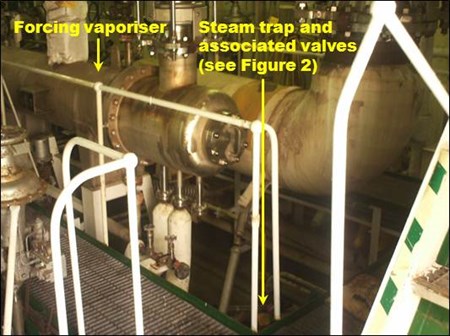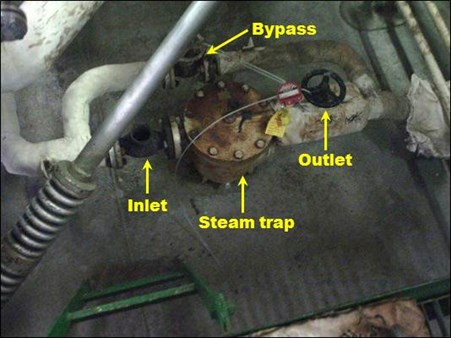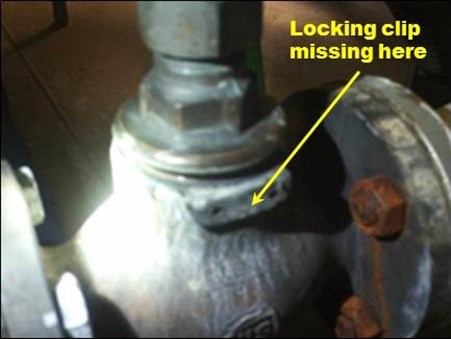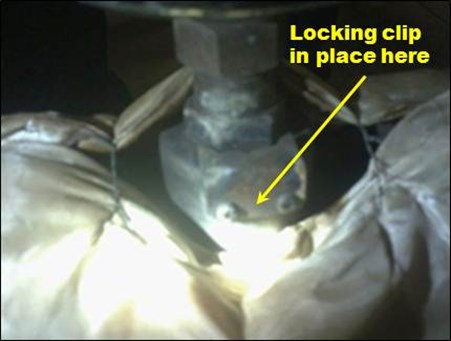The occurrence
A limited-scope, fact-gathering investigation into this occurrence was conducted in order to produce this short summary report and allow for greater industry awareness of potential safety issues and possible safety actions.
What happened
On 6 November 2014, the liquefied natural gas (LNG) tanker Northwest Stormpetrel completed loading cargo and left its berth in Dampier, Western Australia. The ship was then anchored in the harbour to allow the use of excess time in the schedule for its voyage to Japan for in-water lifeboat drills and other maintenance tasks.
The lifeboat drills and some maintenance tasks were carried out on 7 November. One of the tasks planned for the following day (before the ship sailed from Dampier) was to check the LNG forcing vaporiser’s1 steam trap to resolve recurrent drainage issues with the system (Figures 1 and 2).
Figure 1: LNG forcing vaporiser

Source: Shell (photograph annotated by ATSB)
Figure 2: Steam trap and associated valves

Source: Australian Maritime Safety Authority (annotated by ATSB)
At 07452 on 8 November, Northwest Stormpetrel’s engineers discussed the planned task. The cryogenic engineer (cargo engineer) routinely carried out vaporiser-related maintenance and was familiar with its systems and the task.
At 0800, the cargo engineer and the integrated rating (IR) assigned to assist him met on the ship’s main deck. They discussed the task, reviewed its risk assessment and completed a toolbox talk.3 The cargo engineer then went to the cargo machinery room (CMR) on the starboard side of the main deck (where the vaporiser was located) to isolate the system before work on it could start. Meanwhile, the IR went to the engine room to fabricate a new gasket for the steam trap.
In the CMR, the cargo engineer isolated and locked out the forcing vaporiser’s steam supply, outlet, drain and bypass valves. After checking that the system was depressurised, he went to get a permit to work for the task.
The cargo engineer completed the permit to work with the chief engineer, who signed the permit to authorise the work. The cargo engineer then returned to the CMR and started dismantling the steam trap located below the vaporiser (Figure 2).
At about 0900, the IR came to the CMR with the new gasket for the dismantled and cleaned steam trap. The cargo engineer discussed the remaining work with him before re-assembling the trap. The system then needed to be de-isolated and returned to its normal operational condition.
Shortly before 1000, the cargo engineer walked around the vaporiser to check if everything was in order for de-isolating the system. Satisfied with the checks, he removed all the valve lock outs.
The cargo engineer then began carefully opening and closing steam valves, regularly checking if everything was normal. The IR stood by and kept watch for abnormal signs. After the vaporiser’s steam supply valve had been fully opened, the regulator was set to its normal working pressure.4
At about 1000, the cargo engineer decided to fully open the steam trap’s inlet valve that he had earlier cracked open. He had turned the hand wheel of the valve5 about one turn when the valve’s bonnet came away from the valve body. A jet of steam (about 50 mm wide) erupted from the top of the valve’s open body, scalding the cargo engineer’s hands, forehead and neck before he could move clear. After getting clear of the steam, he took off his gloves, safety glasses and hardhat. The IR helped him out of the CMR and, once outside, his boots and overalls were removed. They then hurried to the nearest safety shower and began cooling the cargo engineer’s burns.
At about 1002, the IR called Northwest Stormpetrel’s navigation bridge and reported the incident. The ship’s master initiated an emergency response and a shipboard medical team was tasked to attend the injured cargo engineer. The master then notified authorities ashore of the incident. At 1005, he asked for a medical evacuation to be arranged and then requested medical advice.
At about 1010, the cargo engineer was moved to the ship’s hospital where first aid continued. Over the next hour, he was treated as per medical advice obtained while awaiting evacuation.
At 1122, a helicopter with a paramedic on board landed on the ship. At 1142, the helicopter left with the cargo engineer on board. He was taken to the local hospital, where a doctor assessed his injuries as superficial and admitted him to a treatment ward.
Later that afternoon, representatives from the Australian Maritime Safety Authority (AMSA) and Northwest Stormpetrel’s managers, Shell International Shipping and Trading Company (Shell), boarded the ship to conduct their respective investigations.
The investigations found that the bonnet locking clip on the steam valve was missing (Figures 3 and 4) and this had allowed the bonnet to unscrew and come away from the valve body. The missing clip was not found, nor could it be established when or how it had been lost.
On 9 November, after a replacement cargo engineer had joined Northwest Stormpetrel and Shell’s safety investigation was completed, the ship sailed from Dampier.
Figure 3: Valve with locking clip missing

Source: AMSA (annotated by ATSB)
Figure 4: Similar valve with locking clip

Source: AMSA (annotated by ATSB)
ATSB comment
The steam valve’s bonnet had several threads and unscrewing it to the point of release would have required turning it several times. However, it was reported that the bonnet came away after the valve’s hand wheel was turned only one turn (to open). Therefore, it is likely that when the cargo engineer began to fully open the valve, the bonnet was already partially unscrewed and being held by very little thread. The nearly unscrewed bonnet and its missing locking clip may have been more readily apparent visually and by touch/feel, had the valve’s location been less confined, the lighting been better and greater vigilance been exercised.
Safety action
Whether or not the ATSB identifies safety issues in the course of an investigation, relevant organisations may proactively initiate safety action in order to reduce their safety risk. The ATSB has been advised of the following proactive safety action in response to this occurrence.
Australian Maritime Safety Authority (AMSA)
As the ship’s flag State Administration, AMSA conducted a regulatory investigation and issued Northwest Stormpetrel’s master with an Improvement Notice that required the following action:
Improvement Notice
- Conduct a detailed analysis and review of procedures and precautions whilst working with pressurised systems.
- Specifically address isolation and de-isolation procedures to ensure adequate protection from injury.
Shell International Shipping and Trading Company (Shell)
Shell’s safety investigation identified a number of safety actions to avoid this type of incident.
Procedures and work practices
The safety actions covered shipboard procedures and practices dealing with risk awareness, risk assessment and work planning, permits to work, defective equipment and safety reporting.
Focus areas identified for better risk awareness included joining ship briefings, familiarisation, work site assessments, personal protective equipment and audits. The development of effective risk assessments, their review and using them for work planning and toolbox talks were also identified. An increased focus on permits to work, particularly for invasive and pressurised systems, and the completion and verification of permits were other identified focus areas. Checking for defective equipment and better reporting through training were also noted.
Safety message
Work on pressurised shipboard systems can potentially have a high risk of serious injury. Familiarity with repetitive tasks on these systems can sometimes reduce the perception of that risk. Therefore, it is important that the associated risk controls, such as risk assessments and permits to work, are periodically reviewed and carefully completed to effectively identify and mitigate all risks – including the presence of defective system components .
The ATSB SafetyWatch highlights the broad safety concerns that come out of our investigation findings and from the occurrence data reported by industry. Marine work practices is one of those safety concerns.
Purpose of safety investigationsThe objective of a safety investigation is to enhance transport safety. This is done through:
It is not a function of the ATSB to apportion blame or provide a means for determining liability. At the same time, an investigation report must include factual material of sufficient weight to support the analysis and findings. At all times the ATSB endeavours to balance the use of material that could imply adverse comment with the need to properly explain what happened, and why, in a fair and unbiased manner. The ATSB does not investigate for the purpose of taking administrative, regulatory or criminal action. TerminologyAn explanation of terminology used in ATSB investigation reports is available here. This includes terms such as occurrence, contributing factor, other factor that increased risk, and safety issue. Publishing informationReleased in accordance with section 25 of the Transport Safety Investigation Act 2003 Published by: Australian Transport Safety Bureau © Commonwealth of Australia 2015
Ownership of intellectual property rights in this publication Unless otherwise noted, copyright (and any other intellectual property rights, if any) in this report publication is owned by the Commonwealth of Australia. Creative Commons licence With the exception of the Coat of Arms, ATSB logo, and photos and graphics in which a third party holds copyright, this publication is licensed under a Creative Commons Attribution 3.0 Australia licence. Creative Commons Attribution 3.0 Australia Licence is a standard form licence agreement that allows you to copy, distribute, transmit and adapt this publication provided that you attribute the work. The ATSB’s preference is that you attribute this publication (and any material sourced from it) using the following wording: Source: Australian Transport Safety Bureau Copyright in material obtained from other agencies, private individuals or organisations, belongs to those agencies, individuals or organisations. Where you wish to use their material, you will need to contact them directly. |
[1] When there is insufficient natural boil-off from LNG in the cargo tanks, the forcing vaporiser utilises steam to generate LNG vapour for consumption in the ship’s boilers.
[2] All times referred to in this report are local time, Coordinated Universal Time (UTC) + 8 hours.
[3] A toolbox talk is a safety focussed discussion undertaken by a work team before starting work to cover key elements of the task and the risks involved.
[4] A steam pressure setting of 0.2 MPa that equates to a steam temperature of approximately 120°C.
[5] A screw lift globe valve with a threaded bonnet that is secured with a locking clip.


